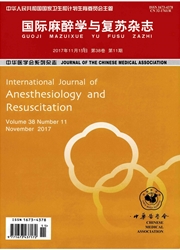

 中文摘要:
中文摘要:
背景脓毒症是病原体感染产生的一种复杂的全身性炎症免疫反应,伴多种器官功能障碍,严重危及生命。机体发生脓毒症时,会同时存在促炎和抑炎两种截然不同的免疫状态,它们之间的强弱变化决定了疾病的病理进程及预后。早期研究认为失控的、持续放大的全身性炎症反应是引起脓毒症患者死亡的主要原因,但临床结果表明抗炎治疗并不能有效改善存活率,有时反而增加病死率。其原因在于随着支持治疗手段的提高,绝大部分患者能够度过严重的全身炎症反应阶段(即免疫亢进期),进入更加复杂的免疫抑制(麻痹)期。处于免疫抑制期的脓毒症患者更易出现继发性感染,并无法控制感染而最终死亡。近年来已经认识到免疫抑制是脓毒症患者死亡的主要原因,脓毒症免疫抑制(麻痹)的研究是当前的研究热点,但治疗手段仍匮乏。目的为诊断和治疗脓毒症提供理论依据。内容综述近年来脓毒症免疫抑制的病理机制的研究进展,并介绍免疫抑制治疗现状。趋向脓毒症的治疗需了解脓毒症的发病机制,实时监测机体所处的免疫状态,并针对性地运用免疫药物进行干预治疗。期望文章能为脓毒症治疗提供新指导。
 英文摘要:
英文摘要:
Background Severe sepsis is a life-threatening disease that is defined as a complex and systemic inflammatory response to infection with the presence of multiple organ dysfunction. When sepsis occurs, both pro-inflammatory and antiinflammatory processes exist in host immunity, and the balance between them determines the pathological progress as well as clinical outcome. An uncontrolled and amplifying pro-inflammatory response was initially believed to be the major cause of mortality in sepsis. However, anti-inflammatory treatments do not improve the survival rate of patients with sepsis, even reduce it sometimes. With the improvement of supporting treatments, most of patients with sepsis can survive from initial hyper-inflammatory phase, but they ultimately die from uncontrolled secondary infection due to the protracted immunosuppressive phase after initial hyper-inflammatory phase. In recent years, it has been increasingly recognized that immunosuppression is the main cause of death in patients with sepsis, however, the treatment for sepsis-induced immunoparalysis is lacking. Objective To provide a theoretical basis for better diagnosis and treatment of sepsis. Content This paper reviewed the latest progress on the pathological mechanisms for sepsis-induced immunoparalysis, and proposed treatment strategies as well. Trend It is necessary to understand the pathogenesis of sepsis, monitor the host immune status, and treat the patients properly based on their immune status. This immune-based therapy will be beneficial for patients with sepsis in clinical practice.
 同期刊论文项目
同期刊论文项目
 同项目期刊论文
同项目期刊论文
 Novel roles of Na+,K+-ATPase ligands in regulating cytokines mRNA stability by HuR signalosome and t
Novel roles of Na+,K+-ATPase ligands in regulating cytokines mRNA stability by HuR signalosome and t Involvement of general control nonderepressible kinase 2 in cancer cell apoptosis by posttranslation
Involvement of general control nonderepressible kinase 2 in cancer cell apoptosis by posttranslation 期刊信息
期刊信息
